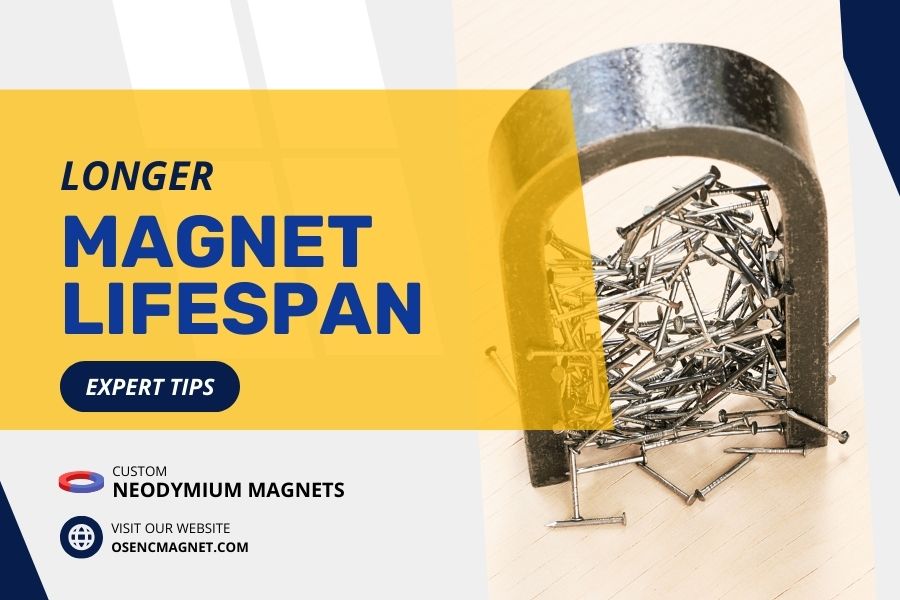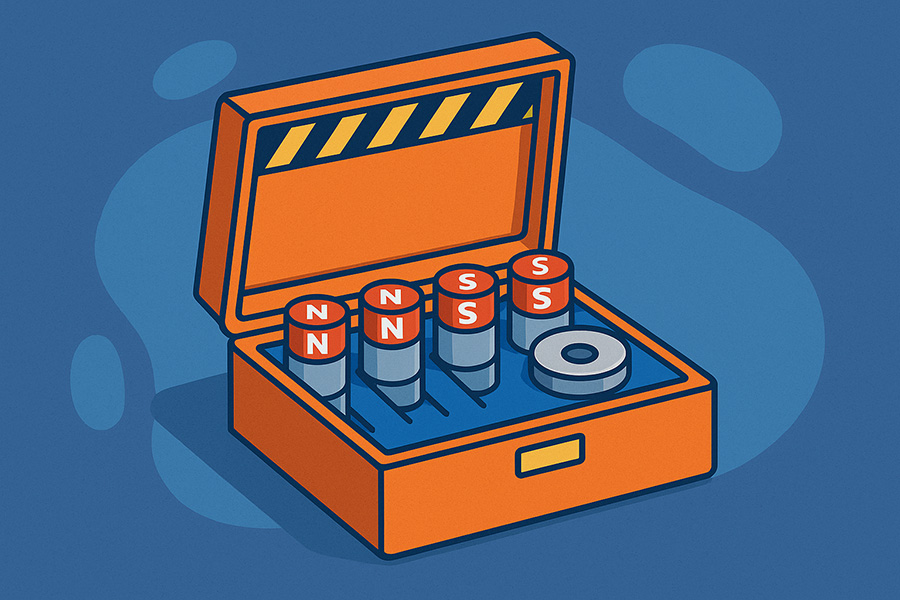To ensure that your magnets remain strong and effective over time, it’s important to follow proper practices.
These include storage, handling, and maintenance.
In this post, we’ll explore some key tips for maintaining the quality and strength of your magnets.
By following these tips, you can get the most out of these strong magnets.
Store Magnets Properly
a. Use keepers
Keepers are small pieces of iron.
They are placed between the north and south poles of a magnet.
This redirects the magnetic field and prevents demagnetization.
- Store magnets in pairs with opposite poles facing each other.
- Never allow like poles to touch as this will cause the fields to repel.
- Repelling fields will weaken the magnets.
b. Keep magnets dry
Store magnets in a dry place.
This prevents corrosion, which can affect their strength.
- If your magnets get wet, be sure to dry and clean them regularly.
c. Use non-ferromagnetic containers
Store magnets in non-ferromagnetic containers like wooden boxes or plastic.
- This avoids attracting metal debris.
Avoid Adverse Conditions
a. Temperature extremes
Keep magnets away from high temperatures.
- High temperatures can alter their chemical and physical properties.
- This causes irreversible strength loss.
Stay well below the magnet’s maximum operating and Curie temperatures.
b. Electrical currents and AC fields
Avoid strong electrical currents and AC fields nearby.
These can disrupt the magnetic field and demagnetize magnets.
c. Mechanical stresses
Protect magnets from mechanical shocks, impacts, dropping, or crushing.
These can cause fractures and strength loss.
Choose Magnets with High Coercivity
Magnets with a high intrinsic coercive force (Hci) can better withstand demagnetizing influences.
- These influences include heat and opposing magnetic fields.
Consult the magnet grade and Hci when choosing materials for demanding applications.
Use Ideal Magnet Shapes
The geometry and aspect ratio of a magnet affects its demagnetization resistance.
- A high length-to-diameter (L/D) ratio provides better protection.
It protects against self-demagnetization and external factors.
Handle Magnets Safely
Wear gloves when handling large magnets to avoid pinches and injuries.
Wear eye protection in case of shattering.
Keep magnets away from electronics, credit cards, and medical devices like pacemakers.
These can be damaged by strong magnetic fields.
- Never allow children to play with neodymium magnets, which can cause serious injury if swallowed.
Keep Magnets Clean
a. Cover magnets with tape
Place a piece of packing tape, masking tape, or other non-residue tape over the surface of the magnet.
This creates a smooth barrier that prevents small metal particles from sticking directly to the magnet.
- If debris accumulates on the tape, you can easily peel it off and replace it with a fresh piece.
b. Use putty or kneadable erasers
Press a piece of putty or kneadable eraser against the magnet surface.
This picks up any attracted metal shavings or dust.
Knead the putty to trap the particles inside so the exterior is clean to use again.
c. Use knife blades or scrapers
Carefully scrape the flat surface of a magnet with a knife blade or sharp scraper.
This physically removes stuck metal particles.
Avoid scratching or chipping the magnet.
Wear gloves for safety with strong magnets that could pinch fingers against the blade.
d. Maintain a clean environment
Regularly wipe down and vacuum work areas and magnet storage locations.
- This minimizes the amount of free metal debris that could be attracted to and accumulate on magnets.
Do Magnets Lose Strength Over Time?
Even with proper maintenance, magnets do gradually lose some of their strength over time.
However, this natural loss of magnetization is a very slow process for modern permanent magnets:
- Neodymium magnets lose less than 5% of their magnetization over an entire century.
- This is when kept in proper storage conditions and not subjected to adverse external factors.
Samarium-cobalt magnets experience very slow demagnetization.
- They lose less than 1% of their strength over 10 years.
- In fact, it takes around 700 years for a samarium-cobalt magnet to lose half its strength.
Ferrite magnets also experience a gradual loss of magnetization.
- This is estimated at less than 2% per year on average, or around 10% over 100 years.
The alignment of magnetic domains in permanent magnets is slowly disrupted over time.
This is principally due to heat and stray electromagnetic fields, which weakens the magnetization.
- Stronger magnets with higher coercivity (resistance to demagnetization) like neodymium maintain their fields for longer compared to weaker magnets.
Wrap Up
So, time does gradually weaken a magnet’s strength.
However, the changes are extremely slow.
This is particularly true for modern permanent magnets when if you properly store them.
You can expect to retain over 90% of their strength for decades or even centuries.


